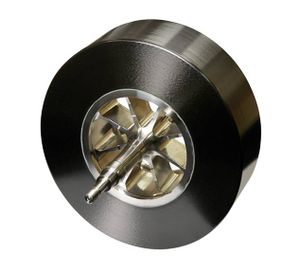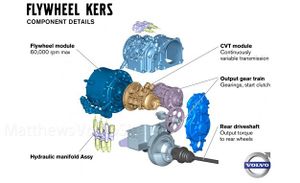Flywheel

A flywheel is a mechanical device which stores energy in the form of rotational momentum. Torque can be applied to a flywheel to cause it to spin, increasing its rotational momentum. This stored momentum can then be used to apply torque to any rotating object, most commonly machinery or motor vehicles. In the case of motor vehicles and other moving objects, the rotational inertia of the flywheel can have an effect due to gyroscopic motion, resisting a change in the direction of the vehicle. If the mass of the flywheel is significant compared to the overall mass of the vehicle, turning and stopping the vehicle is difficult. This fact means careful design of a flywheel is required for application in moving vehicles.
Background
The energy stored inside of a flywheel is related to the speed of its rotation and its moment of inertia. The following equation shows the energy of a flywheel [1]:
where,
• is the energy stored in the rotational momentum (Joules, J)
• is the object's moment of inertia (kilogram * meters2, kgm2)
• is the rotational speed (radians per second, rad/s)
The total stored energy in a flywheel depends on the rotational speed (ω) or the inertia (I) of the flywheel. A typical flywheel consists of a solid cylinder with radius and mass . The moment of inertia, , of this type of flywheel is given by the equation:
To change the inertia of the flywheel, the radius or mass of the flywheel must be changed. There are clear restrictions for increases in these two properties. If the mass of the flywheel is significant compared to the overall weight of the vehicle, the gyroscopic effect will make turning the vehicle difficult. Since most flywheels will need to fit inside of another design, increasing the radius of the flywheel is restricted by the overall size of the system it is used in.
Applications

Flywheels are often used to maintain consistent energy where the normal energy source is intermittent. For example, a flywheel can be connected to the crank shaft of a engine (assuming a manual transmission), storing rotational energy while torque is applied. When the torque is removed, the flywheel can continue to apply torque to the drive shaft, giving the engine a more consistent power output. This type of flywheel set-up was often used on old internal engines, which commonly suffered from engine knock and intermittent output. A lighter flywheel is one of the reasons that small cars can be jerky at low speeds.
Another application of flywheels is to give the drive shaft a power output which is higher than the output of the engine alone. In motor vehicles, flywheels are used to store energy that is applied to the drive shaft during acceleration, giving the vehicle a power boost. Energy can be stored in the flywheel through regenerative braking.
Since flywheels become more effective with increasing size, they are more useful with larger vehicles. Large vehicles have a larger mass which minimizes the effects of gyroscopic motion. Typically, modern flywheels are found in trains, Semi-trailer trucks, and other large transport trucks.[3]
Flywheel braking systems also have applications in Formula one racing. The system in Formula one, refereed to as kinetic energy recovery system (KERS) had a flywheel attached to each of the two drive wheels to store energy. The energy was then used to give the car a power boost of 81 hp for 6.67 seconds per lap, as controlled by the driver using a button on the steering wheel.[4]
Reference
- ↑ Kinetic Energy of Rotation. (n.d.). [Online] Available: http://curricula2.mit.edu/pivot/book/ph1204.html?acode=0x0200
- ↑ "Volvo Working on Mechanical Regenerative Braking" [Online] Available:http://www.matthewsvolvosite.com/volvo-working-on-mechanical-regenerative-braking.html
- ↑ S.J.Clegg, “A review of regenerative braking systems,” Leeds, England. econ.kuleuven.be, 1996.
- ↑ "F1 KERS: Flybrid". Racecar Engineering. Nov 18, 2008. Retrieved Oct 29, 2013

